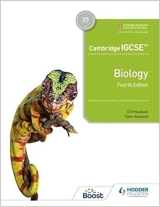Chapter 34. Reproduction
Page 304
1.
|
|
flowering plants |
mammals |
a |
male reproductive organs |
anthers |
testes |
b |
female reproductive organs |
ovaries |
ovaries |
c |
male gametes |
pollen nucleus |
sperms |
d |
female gametes |
egg cells in ovules |
ova |
e |
place where fertilisation occurs |
ovules |
oviduct |
f |
zygote grows into |
seed |
embryo, foetus |
2. Butterfly. The butterfly lays fertile eggs so fertilisation must be internal.
Mussel. Mussels are isolated from each other and are sedentary. Fertilisation is external with eggs and sperms being shed simultaneously into the sea
Trout. Trout have no external genitalia. Fertilisation must be external.
Sparrow. Birds lay fertile eggs so fertilisation must be internal.
Earthworm. Although earthworms couple together to reproduce. the sperms are stored separately from the ova and not released until the ova are placed in a cocoon, Thus fertilisation is external. (This detail is not in the text and there is no way you could reason it out.)
3. Courtship is a behaviour pattern which is principally a characteristic of birds. Mammals have ways of indicating they are ready to mate but this cannot really be described as ‘courtship’. Animals which have external fertilisation have ways of ensuring that sperms and eggs are released at the same time, but this is not courtship. The question is flawed.
Page 305
1. a Asexual reproduction in fungi involves the rapid production and release of large numbers of spores which can be distributed over a wide area and will grow rapidly into new individuals. Asexual reproduction in flowering plants takes place by relatively slow vegetative growth from the parent plant, eventually leading to the development of new plants not far from the parent.
b A spore is a single haploid cell. A seed is a multicellular structure consisting of diploid cells.
2. If the mutant plant is self pollinated it will not breed true and the offspring will be very varied (pp.193, 201). If it can be reproduced vegetatively, the offspring will be identical and the mutant characteristic will be retained.
3. The farmer will have to consider the cost of making the crosses and waiting for the next generation to see if any of the offspring had the combined characteristics. There may be offspring with characteristics which are undesirable and which will attract lower prices when sold. He would have to spend money to keep the pigs isolated so that they could not interbreed. The hybrid pigs will not breed true and may need many generations to stabilise the variation. He will also have to calculate whether the lean, long-backed pigs will attract a higher price.
4. Asexual reproduction does not involve gametes, meiosis, or zygotes.
5. We use asexual reproduction in plants to produce new plants with all the characteristics of their parents, e.g. potatoes, strawberry plants. We also eat the products of asexual reproduction such as potatoes and onions.
6. Birds exhibit parental care, in some cases by building nests and feeding their young. Ground-nesting birds do not feed their young but do show protective behaviour. Most fish do not exhibit parental care and their eggs are often left unattended. As a result, many eggs and very many small offspring are eaten before they can reach adult size and develop effective escape reactions. |
Downloads
Download the answers in PDF format below
Section 1, Chapters 1-5
Section 2, Chapters 6-9
Section 3, Chapters 10-12
Section 3, Chapters 13-17
Section 3, Chapters 18-20
Section 4, Chapters 21-24
Section 5, Chapters 25-27
Section 5, Chapters 28-29
Section 6, Chapters 30-34
Section 6, Chapters 35-37
Section 7, Chapters 38-39
Section 8, Chapters 40-41
|
